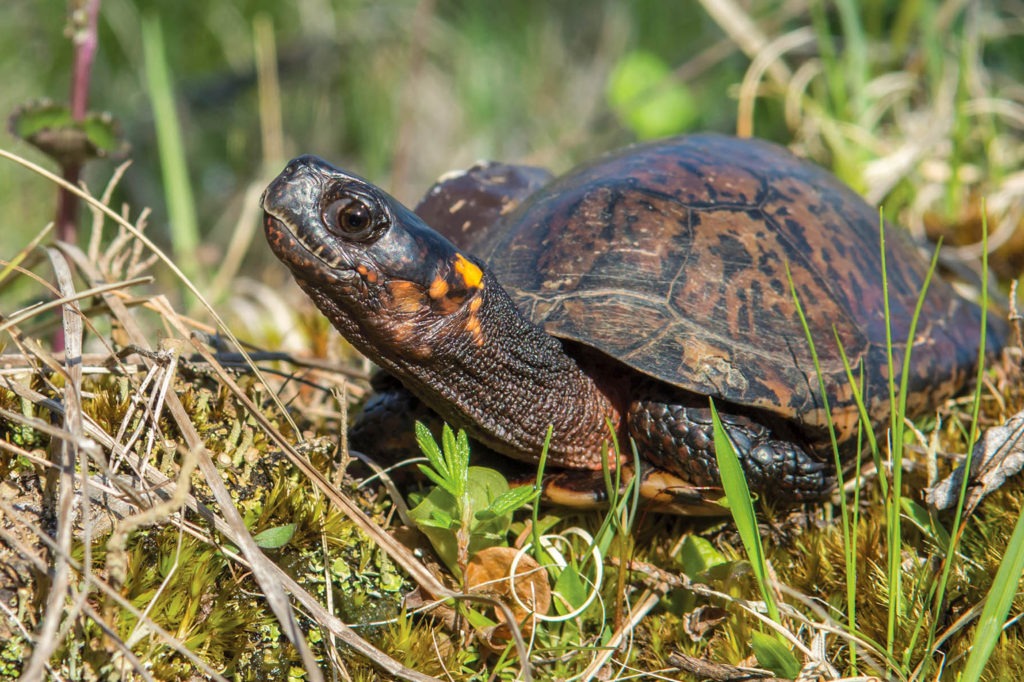Overview
“Where I live”
Bog turtles live in saturated, usually spring-fed wetlands such as bogs, fens, wet meadows, sedge marshes, and older spruce swamps. They prefer relatively open wetlands with slowly flowing streams, rivulets, or surface seepages. These wetlands are usually dominated by clumps of grasses and sedges, and have soft muddy bottoms.
At The Maryland Zoo, bog turtles can be seen in the Meadow in the Maryland Wilderness area.
“How I live there”
Bog turtles are active for about half the year, during the warmer months. They hunt and forage during the day but are not readily visible because they often hide under vegetation.
For the other half of the year, during the colder months, bog turtles brumate. They bury into the mud or submerge themselves in the water of underground springs.
“Making my mark”
The bog turtle is a tiny black-skinned turtle with telltale orange patches on either side of its head. Only one inch long at birth, it seldom exceeds four inches and weighs no more than five ounces, which is less than a baseball. Although one-third of all bog turtles live in Maryland, few people ever see one in the wild because they inhabit inaccessible wetlands and are shy by nature.
The bog turtle – also known as Muhlenberg’s turtle – was first discovered in 1778 by Reverend Heinrich Muhlenberg, a Lutheran minister and self-taught botanist. He came eye-to-eye with the tiny turtle while on his hands and knees studying grasses in a wetland area in Lancaster County, Pennsylvania. He delivered specimens of the miniature turtle to his friend, Johann David Schoepff, who first described and named it in 1801.
“What eats me”
Raccoons, foxes, skunk, and dogs are all known to prey on bog turtles. Bog turtles are also vulnerable to people who take them from the wild to keep or to sell as pets.
Raising Young
Bog turtles mate primarily in the spring. Females build their nests and lay their eggs in late spring and early summer, mostly during the month of June. Each female normally lays one clutch of 1-6 eggs per year. She chooses a sunny spot, and the eggs incubate for 45-65 days. The baby turtles hatch in early fall and may spend their first winter in their nests before emerging the following spring. Once the baby turtles hatch, they are on their own.
Turtle, tortoise, or terrapin?
All turtles, tortoises, and terrapins are reptiles belonging to the taxonomic order Chelonia (from the Greek for “tortoise.”) All have scales, lay eggs, and are ectothermic. The different common names can be confusing and aren’t perfect distinguishers, but generally the term “tortoise” refers to a land-dweller. They have strong legs and round, stumpy feet made for walking on land. They tend to live in dry, hot places. Turtles spend most of their time in water and terrapins live on land and in water, and are always found near water.
Conservation
Only half as many bog turtles live in Maryland now as in 1980, and they are considered a threatened species. They are victims mainly of vanishing wetlands. Bog turtles cannot survive without wetlands habitat, and thus wetlands restoration is a very important aspect of their conservation. Landowners across the state are now being encouraged by Maryland’s Department of Natural Resources and other conservation-minded organizations to preserve wetlands on their property rather than draining and filling.
The best thing that you can do for bog turtles is to leave them and their habitat undisturbed. If you visit wetlands, tread lightly and stay on designated paths. Never touch or relocate any species of turtle in the wild, and never remove a turtle from the wild. If you encounter anyone collecting or selling bog turtles, please notify the Maryland Department of Natural Resources.
Taxonomy
- Kingdom: Animalia
- Phylum: Chordata
- Subphylum: Vertebrata
- Class: Reptila
- Order: Testudines
- Family: Emydidae
- Genera: Clemmys
- Species: muhlenbergii


